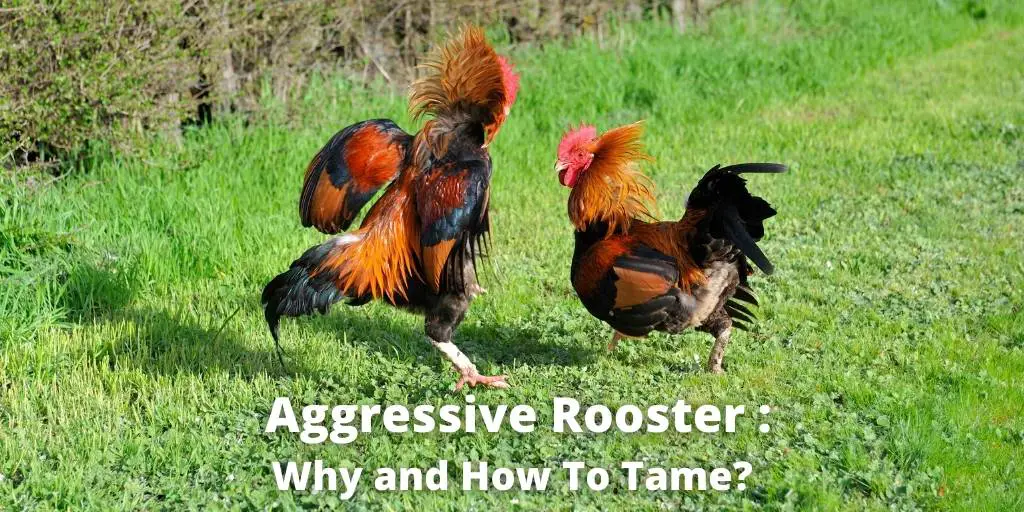
Do you have an aggressive rooster? If yes, you may be finding some ways to tame him and make him a good boy.
This guide will help you to know what is an aggressive rooster, why they get angry, their behavior, and easy ideas to control them.
Additionally, we have added a few tips to protect yourself from an attacking rooster. If you are a newbie chicken raiser, hen vs. rooster guide may also help you.
What Is an Aggressive Rooster?
An aggressive rooster is one that will attack humans and other flocks in the coop and run. It’s not always clear why some roosters are more prone to aggression than others, but there are some things you can do to minimize the risk of provoking aggressive responses.
Moreover, you can reduce their anger or tame the rooster if you will find out the actual cause of the anger. Mostly, the topline roosters in the pecking order tree are more aggressive.
Why Do Roosters Attack? — Common Reasons
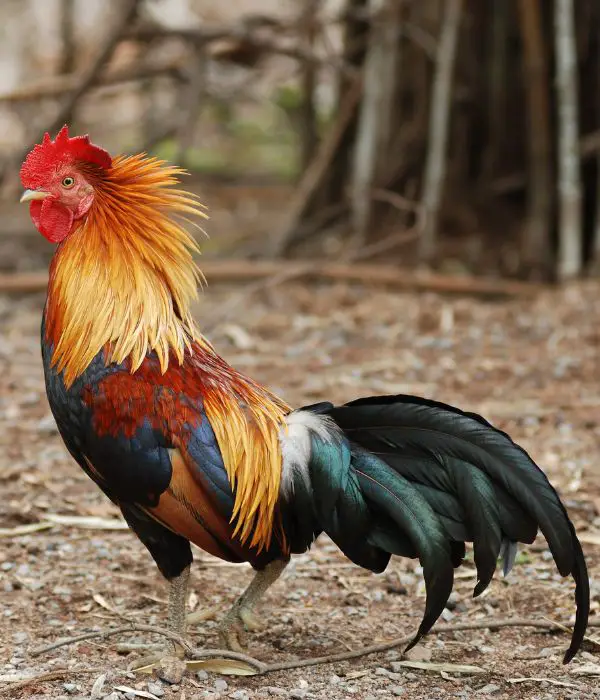
Roosters are very territorial animals and have a huge amount of pride within their flock mates like hens and pullets. When they start to feel threatened, they will usually try to fight back.
Below are some reasons why roosters may feel threatened and may attack:
1. Physical assault
If you physically harm a rooster, it will react in self-defense. This can occur with a rooster that you are attempting to catch and put into the transport cage.
Some people mash on the rooster’s head when attempting to catch it, which can lead to a peck back.
2. Unwanted contact or touching
Any unwanted touching, or rubbing, of the body of a rooster will often result in an aggressive response. An aggressive response is normal if you contact a rooster that you don’t want to breed or that isn’t yours.
3. Trespassing
If a rooster feels that your presence in its house is unwanted, it will likely attack you. Only enter the chicken coop if you are there to do so.
If you are just there to feed it, then you should always ask permission first. Make some calling sound for feed, they will not harm you.
Not only this, rooster do not allow other roosters in their area. So, usually, they fight.
4. Rooster Coop
A rooster will typically become angry if something happens to its home. It becomes territorial, and fights to defend the property. Any damage or disruption your rooster sees as a threat, will likely result in a fight.
5. Hormone levels
Some main hormones in roosters are testosterone, and cortisol. Testosterone generally increases aggression, and high-stress levels can cause a spike in cortisol. A hormone imbalance can lead to increased aggression.
6. Any change to the coop
If you move a rooster’s nest, or rearrange its sleeping area, then it may become aggressive. You must do not move your rooster’s perch, drinkers, feeder to a different place in the coop.
If they are moved, they will often become stressed. Most of the stressed rooster become aggressive to owners.
7. Wrong rooster vs. hen ratio
You must know the correct rooster and hen ratio in the coop. Usually, a rooster is good with 3-5 hens.
If you add another one rooster in that group, it will increase the anger in both the rooster. So, for maintaining a healthy and non-aggressive environment, keep the proper ratio of male and females.
The Common Behavior of an Aggressive Rooster
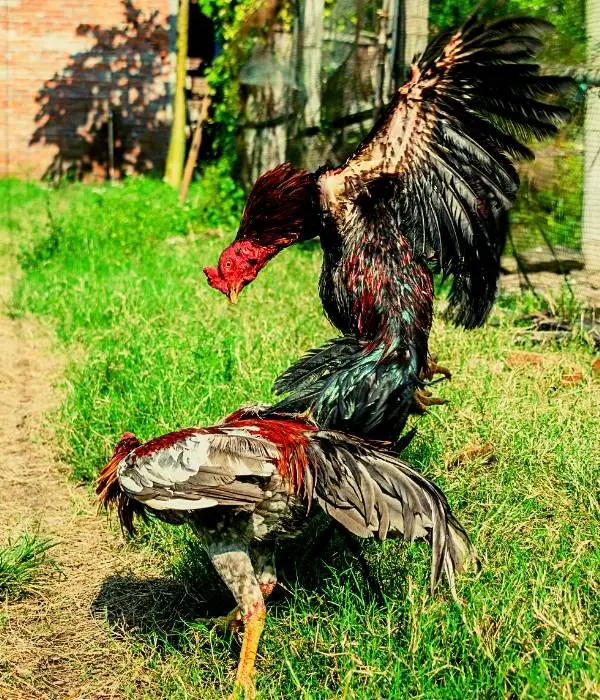
There are many ways that a rooster can become aggressive. It is significant that you are aware of anything a rooster could do, to harm you. Some signs to look out for are:
1. Raised hackle feathers
The hackles on an aggressive rooster will stand very high and erect. This is a sign that the rooster may be preparing to attack. The feathers typically form a sort of shield, to protect the hen regularly found beneath them.
2. Staring directly at you
Every rooster wants to look its owner in the eye. If a rooster stares very intensely, and is not interested in what you have to say, then it’s probably a good idea to leave them alone.
3. Roosting on the perch
An aggressive rooster will stand very upright, and often have its neck stretched out. The rooster will typically be in a very dominant position, and you should avoid it.
4. Shedding feathers
If a rooster starts to shed plenty of feathers, then it is likely that it has lost its pride. This can be caused by a feeling of being intimidated in its house, or being afraid.
In these types of situations, most of the rooster become aggressive and show their anger to any person who go near them.
5. Flogging
A rooster will flap its wings aggressively if it wants to intimidate you, or it is angry. It is a sign that it would like to move towards you, or attack.
6. Sounding
If a rooster sounds very loud, and angry, then it has every intention of fighting. Sounding is frequently a sign that a rooster is actually not angry, but rather just warning you of its intentions.
7. Flapping its wings
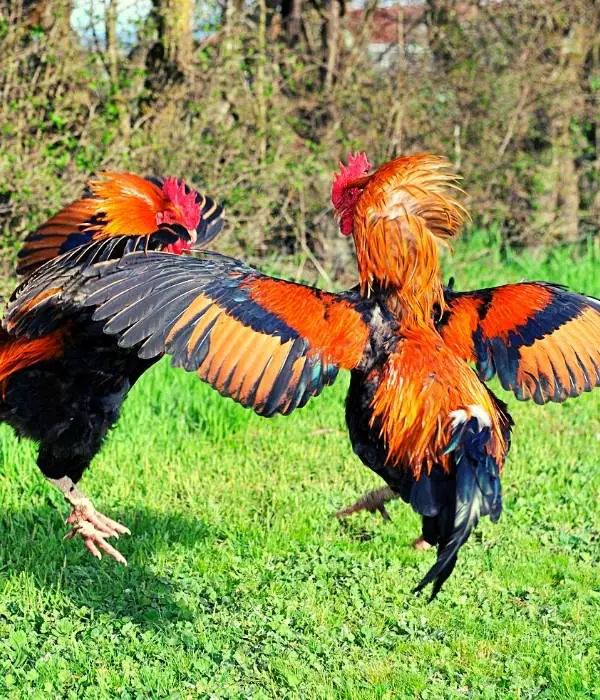
Flapping the wings is a sign of frustration. It acts as a form of “signaling”, in which it calls out to other roosters. If you see a rooster flapping its wings and acting frustrated, then it’s probably after a fight.
8. Flicking its tail
A rooster will often flick its tail, to alert others of its intention to fight. A rooster will always tell you that it is preparing for battle by doing this, as it has every intention of fighting.
9. Jumping
A rooster will frequently jump when it is angry. It will try to intimidate you with this, and cause you to fear it. If you see a rooster jumping, then it is a sign that you should leave the poultry house right away.
During jumping, most of the rooster attack with their spurs. So, stay away from those aggresive roosters having long spurs.
10. Head shaking
This is a very aggressive behavior of roosters, and can be a sign that they are preparing to attack. Any head shaking will regularly be followed by a peck, which could cause serious injury.
11. Backing up
This is an aggressive behavior of roosters, and can typically be a sign that it is preparing to attack. Any rooster will push forward when it feels threatened, and try to get you out of the way or out of the house.
How to Tame an Aggressive Rooster?

If a rooster has been aggressive towards you, then for the love of god, do not get violent. If you physically harm a rooster, it will become very aggressive in defense. There are some ways to calm it down, and make it less aggressive:
1. Don’t fight back
If your rooster has attacked you, then do not physically fight back. This will only encourage the rooster to continue attacking you, and will therefore be more aggressive.
2. Be confident
If you act submissive towards your rooster, then it will become more confident. If you act confident when the rooster is trying to intimidate you, then it will often not attack.
3. Consider rehoming him
The most recommended step you can take is to rehome him. A rooster that is aggressive towards you at home, will most likely be aggressive to every person it sees. It is best to rehome it, as it will attack again.
4. Give him some treats
If your rooster is not aggressive, and you want to make it feel less aggressive, then you should try giving it treats. This will encourage a good relationship, and will typically tame the bird down. If you’re good at animal care, then you can give weekly treats to calm a rooster down.
5. Get another rooster
If a rooster has been aggressive towards you, and you want your rooster to act more friendly towards you, then get a new one. The two will get along better if they were not raised together.
This will also prevent the aggressive rooster from becoming more aggressive, and making the new rooster feel awkward.
6. Understand your environment
The environment that your rooster is in is important. You should make sure it isn’t getting too hot, or too cold. If it’s not given a nice environment to live in, then it will become aggressive.
If a rooster’s environment is too small, or cramped, then it will become aggressive. Roosters are territorial, and they fight to the death over little things.
7. Spend some time In their territory
If your rooster is aggressive towards you, it will most likely be in the same area that you are. You should try spending some time in the territory of the rooster. This will make it feel more at ease, and less aggressive.
8. Try not to chase it
If you chase the rooster, then it will often become aggressive. This will cause you to feel threatened and will cause your rooster to feel more aggressive as well. If you want your rooster to not attack, then don’t chase it.
How to Protect Yourself From a Rooster Attack?
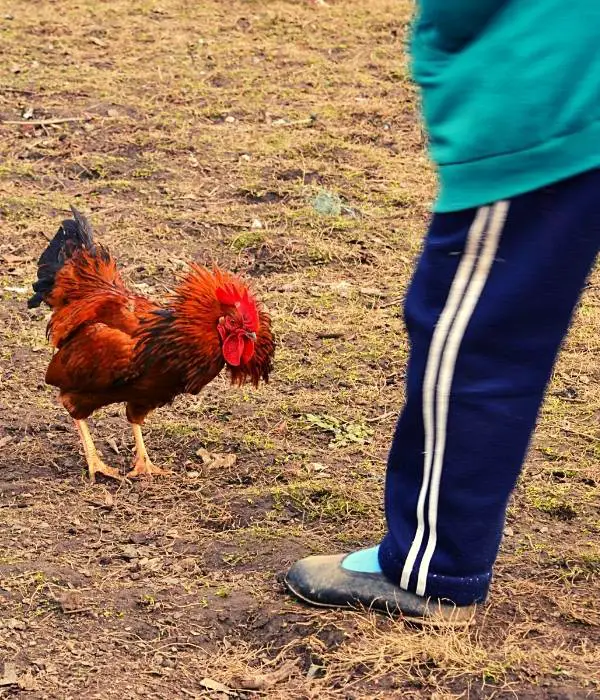
To protect yourself from an attack, you should try to act confident. If you are confident, and not intimidated by the rooster, then it will frequently not attack you. Make sure it can see that you aren’t afraid of it, or something else won’t want to fight it.
Below are some tips to protect yourself from an attack:
1. Don’t Run
If you run, it will regularly make the rooster feel more aggressive and will try to chase you. If you make it think that running is a good idea, then it will start chasing you.
2. Don’t Get Too Close
If you try to get too close to your rooster, then it will often attempt to attack you. If the rooster gets close enough, then it will try to peck your skin. This is what it does to the hens at night.
3. Wear the right clothes
Know your rooster’s body language. If it is in its territory, or its territory is nearby, then it will regularly be aggressive. If you wear the correct clothes, then people will have a hard time accusing you of being aggressive.
You should wear something that is hard to break and take off. Things such as thick jeans, farm boots, and jackets are great for this.
4. Have a stick on you at all times
If a rooster becomes aggressive towards you, then try to hit it with a stick. They are excellent at fighting, so you will want something to knock them out or cause them to run away.
5. Get some companions
Your rooster will not attempt to attack you if you have some companions with you. This will sometimes cause the rooster to peck at them instead of you.
6. Stay Away From Young Roosters
Young roosters are generally very aggressive, and will try to attack you. If you keep away from them, and let them grow up a little, then they will often become more docile.
7. Take them for a walk
If you take your rooster for a walk, then it will frequently get tired out and be fairly docile. When it is tired, it will typically stay on your shoulder, and not try to attack you. You can use a chicken harness to control him if you are going to a public place.
8. Trimming rooster spur
Trimming rooster spurs is one of the best ideas to stay safe from an aggressive rooster. During their flying and jumping attacks, roosters attack using spurs.
Spurs are very dangerous because they can cause severe bleeding injury. You can use a spur glove to cover the sharp part of the spur.
Conclusion
Many people are surprised that roosters are aggressive animals, but they shouldn’t be. These animals are very territorial, and will typically attack anyone who threatens their turf. They will set out to find an easy target, and when they do, they waste no time going after it.
If you have a rooster that has attacked you, then it is best to tame it. If you let the rooster remain aggressive, then it will be effortless for people to accuse you of being the same.
To tame an aggressive rooster, you should let it know that you don’t take its behavior lightly. If you fight back against the rooster, it will definitely become more aggressive for sure.
You should be confident when the rooster is trying to break into your territory, and show it that you won’t run away. If the rooster feels threatened, then it will most likely retreat.
If a rooster has been aggressive towards you, then do not try to take revenge. It will just cause the rooster to get more aggressive. You should instead try to understand your environment.


Leave a Reply